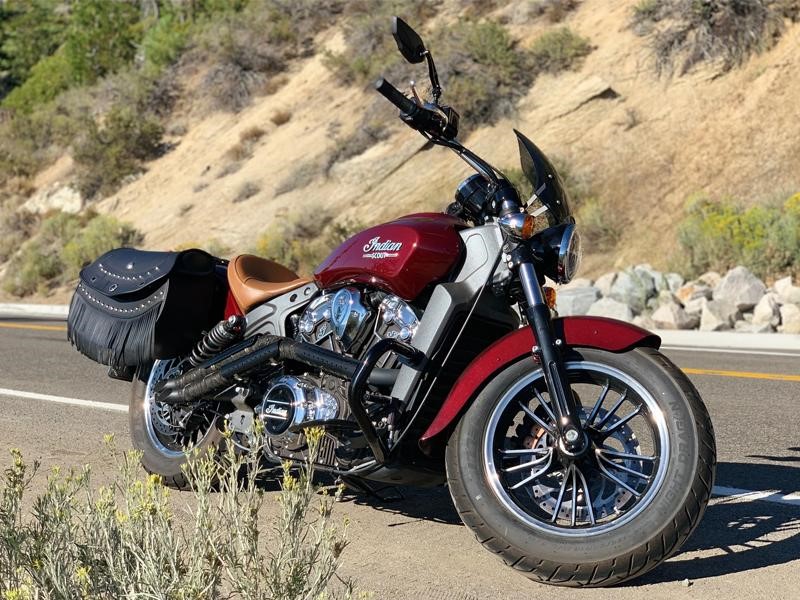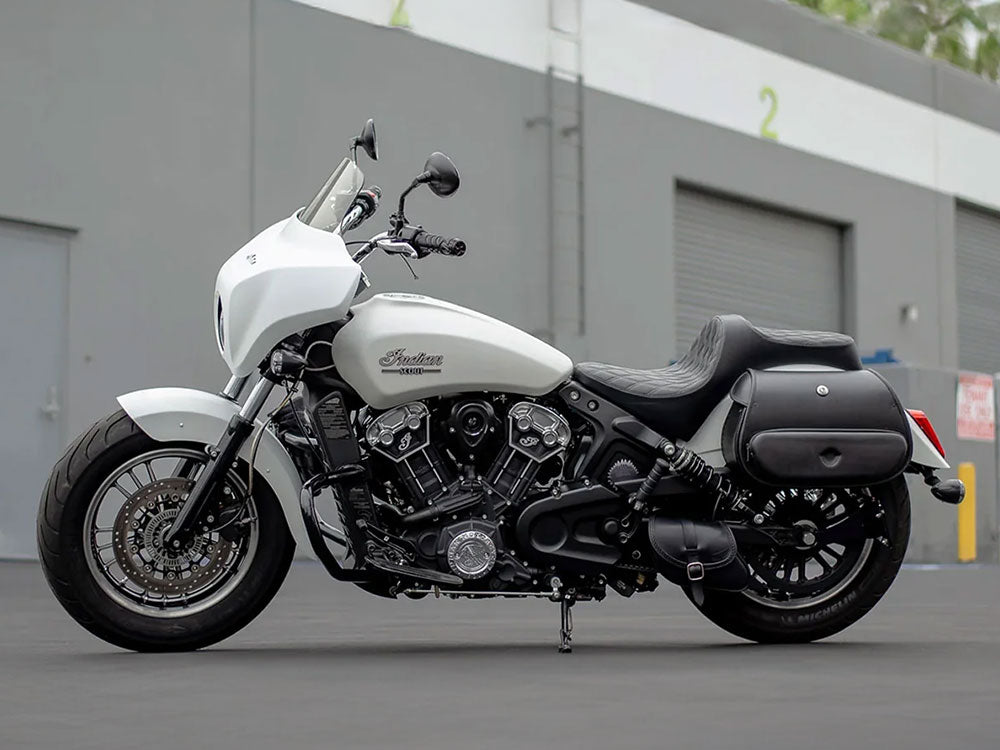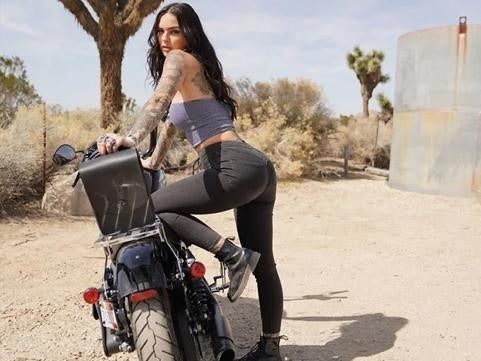Table of Content
1. A BRIEF HISTORY OF INDIAN SCOUT:
Indian Motorcycle was founded in 1897 by the Hendee Manufacturing Company . Later on, in 1923, the company changed its name to Indian Motocycle , with there being no “r” in Motorcycle. With the passage of time, the name of the company became Indian Motorcycle.
The company launched many models over the year. The Indian Scout was released in 1920 . At that time, the Scout was considered very reliable and fast , which convinced many people to start riding motorcycles.
1.1 Indian Scout 101, 1928:
In 1928, a new version of the Indian Scout was launched named the Scout 101. The newer version was a success and many bike enthusiasts loved it very much. According to enthusiasts, the Scout 101 was the best motorcycle Indian ever made.
1.2 Indian Standard Scout, 1932-1937:
In 1932, the new version of Scout 101 was launched which didn’t have any specific changes other than a heavier and bulkier body compared to the original Scout 101. This bike did not leave as many marks on the heart of enthusiasts as the original Scout 101.
1.3 Indian Scout Thirty-Fifty Scout, 1932-1941:
The Standard Scout was not much of a success so the company launched a new bike in 1933 which had the same engine as the Standard Scout that was fitted into a discontinued Indian Prince. The engine had more power in the new bike compared to the weight of the Indian Prince. Therefore, the engine displacement was decreased to 30.50 CU (499.8 CC). That new version was named the Pony Scout.
1.4 Indian Scout Sport Scout, 1934-1942:
Despite their designs, s the Standard Scout and Pony Scout were not big successes for the company. Therefore, the company made the Sport Scout in 1934 which had better carburation, alloy heads, girder fork, and a much lighter frame.
1.5 Indian Scout Military Scout, WWII:
During World War II, the Indian sold around 30,000 units of the Scout 741 to the British military. The Scout 741 used in WWII was actually a military version of the Thirty-Fifty Scout .
1.6 Indian Scout Post-War Scout, 249 and 648:
In 1946, the Indian Motorcycle Company made around 50 units of the Scout 648 that were mainly given to racers only. The Scout 648 was a huge success and was known as Big Base. In 1949, the Indian Motorcycle Company made the Scout 249 on a larger scale than Scout 648.
In 1951, the Scout 249 was launched with the name Warrior with a 500 cc engine, while the Scout 249 had a 436 cc engine. The Warrior was launched to compete with the European 500cc.
2. Indian Scout AT FIRST GLANCE:

2.1 Indian Scout Design and Styling:
The 2015 version of the Scout is one of the best-looking cruiser bikes. The Indian Scout’s center of balance is low. Hence, it feels very comfortable when you are driving and handling. The Indian Scout is considered to be one of the best bikes for traveling over long distances. It is similar to the Victory Octane in design but there are differences between the two. The Scout has a good seating position that puts riders within reach of the handlebars which makes it easier for riders to grab hold of the handlebars.
2.2 Indian Scout Engine:
The Scout’s engine is a four-stoked, liquid-cooled V-twin engine with a displacement of 69 cu (1,133cc). It is a closed-loop fuel injection engine with a bore size of 66 mm with a six-gear transmission. The Scout’s engine contains an extraordinary horsepower of 100 hp which can provide a maximum torque of 97 Nm with 5,600 rpm.
2.3 Indian Scout Fuel Mileage and Capacity:
The Indian Scout has a fuel capacity of 3.3 gallons (approximately 12.5 L) which is a bit low compared to other cruiser bikes. The Indian Scout keeps 3.0 L in reserve but it has a mileage of 43 mpg. However, some riders still feel that the fuel capacity should be a bit more than 3.3 gallons.
2.4 Indian Scout Brakes:
The Indian Scout has excellent braking. The brake levers are easy to use. You must exert more force on the rear brakes compared to the front wheel brakes. The newer versions of the Indian Scout come with an optional ABS but it costs more to have it installed. Both brake discs have a diameter of 298 mm.
2.5 Indian Scout Transmission:
The Indian Scout has a six-gear transmission with a gear drive wet clutch. The first gear can bring the ratio up to 10.926:1 which can give an extra push and burst of speed. There is no chain transmitting power from the engine to the transmission.
2.6 Indian Scout Electricals:
The Indian Scout has a maintenance-free battery that helps power the lighting system Its front light is a halogen bulb and the rear light is an LED.
2.7 Indian Scout Suspension:
The front suspension of the Indian Scout is very soft. If the rider weighs more than an average person, then the rider may feel that the front shocks compress from three inches to five inches when seated. If the rider is of average weight, then the rider might not feel any discomfort.
The rear shocks are very satisfying whether the rider weighs heavier than a normal person or not. They compress and decompress easily.
3. Indian Scout A BUYER’S GUIDE:
3.1 Is an Indian motorcycle a good beginner bike?
For a beginner, it is recommended they pick a bike that is easy to handle. If you know the fundamentals of driving, then the Indian Scout can be a very good choice for a person who has already ridden bikes. But if a person is totally new to riding a bike, then an Indian Scout might be too dangerous. Keeping in mind that the Scout is fitted with a 1,133 cc engine, that much power may be too much for a beginner to handle. For a beginner, it is better to ride a bike with less engine power will be a good choice.
3.2 Are Indian motorcycles respected as much as Harley Davidson?
Both companies originated from the United States, with Harley Davidson being founded two years later than the Indian Motorcycle. But unfortunately, both do not share the same respect among motorcyclists. The only reason the Harley Davidson bikes are more famous is that they have more publicity through movies, ads, and celebrities. No doubt Harley Davidson bikes have good looks and performance. On the other hand, Indian bikes have not gotten as much attention as Harley Davidson, although their Indian Scout set the fastest speed record in 1962, 1966, and 1967. Still, Harley Davidson is ahead in terms of fame and publicity.
3.3 Are they still making Indian motorcycles?
Yes, Indian Motorcycle Company is still making their bikes. Although they have not made many changes in the design of their bikes for almost seven years, they have upgraded the performance and overall user experience.
3.4 Is an Indian or Honda motorcycle better?
Both companies are the best when it comes to manufacturing. If you seek a motorcycle with more horsepower or more speed, the Indian motorcycle is the better choice. But if you seek a bike that is reliable and fuel-efficient, then pick a Honda model. Indian motorcycles are fast because of their horsepower and much bigger engines. However, Honda also makes fast bikes but they are more well-known because of their reliability and are fitted with different engines compared to the V-Twin engine.
3.5 Do Indian motorcycles hold their value?
Yes, they do hold their value if you consider the price at which they are sold, their performance, and the quality of service that the company provides.
3.6 What are more reliable: Harley Davidson or Indian motorcycles?
In terms of reliability, both are good brands that make excellent bikes in terms of power and speed. The interesting contrast is that if you own an old Harley Davidson bike you will still be able to get its parts, but that’s not the case with an Indian motorcycle. If you own an old Indian Motorcycle, you might face problems while trying to find spare parts.
3.7 Which Indian bike is good for a long trip?
Indian Motorcycle Company manufactures a lot of good bikes for different purposes but the Indian Roadmaster is the best for long-distance trips. The company is also making Indian Challenger Dark Horse , Indian Springfield , Chieftain , etc. All of these offer good value and can be used for long-distance trips.
4. Indian Scout A DETAILED SPECIFICATION:
4.1 Engine
| Engine CC | 1131.0 CC |
| No of Cylinder | Two |
| Maximum Power | 99.9 bhp @ 8099 rpm |
| Maximum Torque | 97.7 Nm @ 5600 rpm |
| Valves per cylinder | Four |
| Fuel System | Closed-Loop Injection/ 60 mm bore |
| Cooling System | Liquid-Cooled |
| Starting Mechanism | Self-Start |
4.2 Fuel Consumption and Mileage
| Total Fuel Capacity | 3.3 gal (12.5 L) |
| Reserve Fuel Capacity | 0.8 gal (3.0 L) |
| Mileage | 43 mpg (18.6 Km/L) |
| Overall Riding Range | N/A |
4.3 Drivetrain
| Primary Drive | Gear Drive Wet Clutch |
| Clutch | Wet, Multi-Plate |
4.4 Dimensions
| Kerb Weight | 244 kg |
| Length | 2,324 mm (91.5 in) |
| Width | 916 mm (34.6 in) |
| Height | 1,068 mm (42.0 in) |
| Wheelbase | 1,575 mm (62 in) |
| Ground Clearance | 146 mm (5.7 in) |
| Seat Height | 649 mm (25.5 in) |
4.5 Transmission
| No of Gears | Six |
| Drivetrain | Belt type |
4.6 Chassis and Suspension
| Chassis Type | Split Dual Exhaust with Crossover |
| Front Suspension | Telescopic Fork/4.7” (120 mm) |
| Rear Suspension | Dual Shocks/3.0” (76 mm) |
4.7 Braking
| Front Brake Type | Disc |
| Rear Brake Type | Disc |
| Front Drum/Disc Size | 298 mm |
| Rear Drum/Disc Size | 298 mm |
4.8 Wheel and Tyres
| Wheel Size | 16 in |
| Wheel Type | Alloy Wheels |
| Front Tyre | 130/90-16 72H |
| Rear Tyre | 150/90-16 72H |
4.9 Electricals
| Battery | Maintenance Free |
| Head Light | Halogen Bulb |
| Tail Light | LED |
| Gauges | Digital Speedometer with Digital Tachometer, Engine Temp, Trip meter, Low Fuel Lamp, Odometer, |
4.10 Others
| Colors | Black Metallic, Maroon Metallic, Silver Quartz Metallic/ Black |
5. AFTERMARKET PARTS & MODIFICATION OPTIONS FOR INDIAN SCOUTS
Overall, the Indian Scout is designed with a good combination of parts but there are some modifications that many riders like to make. The front shocks seem to be very low, intended more for a heavyweight person. So, many riders who are more than average weight like to change out the front shocks. In terms of performance, reliability, speed, and engine power, riders tend to be satisfied with that.
Some riders are not very pleased with the fuel capacity of the Indian Scout, so they keep an extra bottle of gasoline with them in their SADDLEBAGS. If riders want to travel over long distances, they prefer to install INDIAN LUGGAGE BAGS and LUGGAGE RACKS because none of them are installed in a standard variant of the Indian Scout. For better experience and comfort people use more COMFORTABLE SEATS, RIDER AND PASSENGER BACKREST, and FAIRINGS. Fairings help protect the bike from dirt and mud. They also help to reduce any drag caused by wind resistance.












Leave a comment
All comments are moderated before being published.
This site is protected by hCaptcha and the hCaptcha Privacy Policy and Terms of Service apply.